The public hallmark of the resurgence of the bicycle is the bike lane. We lust for them, we beg for them, we cheer them when they are finally painted along the side of the road.
As much as I love seeing them, I have to admit that my feelings about most bicycle lanes are mixed. While many of the newest lanes in SF are well placed and very much needed to get people on the street on their bicycles, much of what we have is substandard by any measure out there. The above lane is fantastic for showing all road users where they should be to move in certain directions and has made this stretch of bicycle route a whole bunch better to ride on. In spite of this improvement, the lane is still either squeezed to the right of, or smack dab in the middle of, 30 mph traffic. No measure of traffic calming was employed here, no reduction in traffic speed, no physical separation of bicycles and cars (there is a buffer zone on the straightaways, but that can feel a bit flimsy when there is delivery truck straddling it). During rush hour, when this stretch is packed with people in cars who are late-late-late, you have to be pretty centered with a healthy dose of trust in the ability of others to drive in a straight line.
This next picture is of Valencia Street. The three most prominent bicycle routes in San Francisco are The Wiggle, Market Street and Valencia. Of these, Valencia St. has experienced the greatest change recently with huge traffic calming and reduction planning, removal of parking and turning lanes, widening of sidewalks and conversion of unused bus stops into bike corrals. These measures have helped to increase the number of cyclists greatly in the last few months and every time I ride there I see more and more people cruising along to get where they are going. Every inch of bike lane on Valencia Street is planted firmly in the door zone and while it is a showcase of new bicycle infrastructure for SF it is also some of the most popular double parking and cell phone space in the City. Having a large police station and many parking enforcement officers to monitor the meters makes no difference either as no one ever issues any tickets.
This lane is on Cabrillo Street and is one of the oldest lanes in SF. It is a fantastic lane as it is firmly established outside the door zone and is striped on both sides to clearly show this to riders and parkers alike. There are many out there, like myself, who wonder why the new lanes are not planned as well as this. We also wonder what will come of this in the long run.
New riders who do not have a great deal of experience on the road frequently see bicycle lanes as a promise of safety from traffic. They don't have the experience to recognize the door zone or the reflexes to dodge doors while not getting hit by passing traffic. Or better yet, be comfortable enough to be able to recognize the cars with the potential to have a door open into them. New riders think they have to stay in the lane to be safe and then become targets for the dreaded right hook. They frequently do not know how to get out of the lane to either get around right turning vehicles or to merge with traffic to make left turns themselves. Many people feel uncomfortable taking the lane because they feel they are getting in the way (not a problem I have) and will not come out of the bicycle lane even when they recognize it at as substandard.
A lot of energy goes into discussions of how bicyclists should behave. There is a lot of discussion about the need to stop at signs and not ride on sidewalks and be polite... and while I agree that riding predictably and with the needs of others recognized makes for a much more pleasant experience for all, unless we address the true problem, total lack of infrastructure that makes it impossible to ride in something other than survival mode, we will always have unpredictable riders.
Between doors and pedestrians in the bike lane, even pedicabs have to take the lane.
If delivery trucks and people checking their GPS systems insist on doing so in the bike lane then we will have to resign ourselves to cyclists darting into traffic to get around them.
If bike lanes are placed in the door zone then we will have to resign ourselves to more aggressive riders because they can not safely use the space that has been allotted to them. Want to see a really frustrated driver? Then watch them get upset when they get stuck behind a cyclist who has to take the lane instead of using the substandard bike lane that has been given them. Who will get blamed in that situation? It won't be the institutions that put in the badly planned lane, it will be the cyclist who is trying to keep from getting doored.
If the only standard of street planning is moving the most cars as fast as possible then we can not complain when some cyclists behave in what feels like aggressive or erratic manners. The lack of infrastructure is the cause, the cyclists are just the symptom. If you maintain a road system that encourages drivers and cyclists alike to behave like the Running of the Bulls then you can not get angry at the users for doing so. There will be those who take the part of "the bull" and those who take the part of "let me get the hell out of the way".
When bike lanes work, people are happy.
If we want to stop the "bad behavior" we need to start building like Portland. If we want new cyclists to join the ranks then the need for articles like this or today's article at Streetsblog need to be eliminated by building better bicycle accommodations.
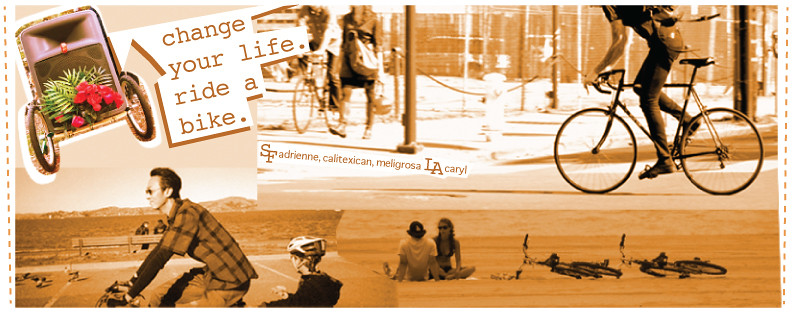
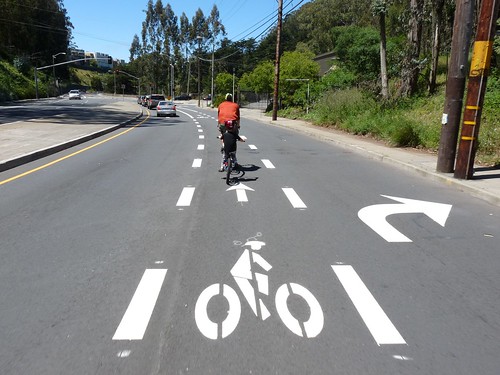
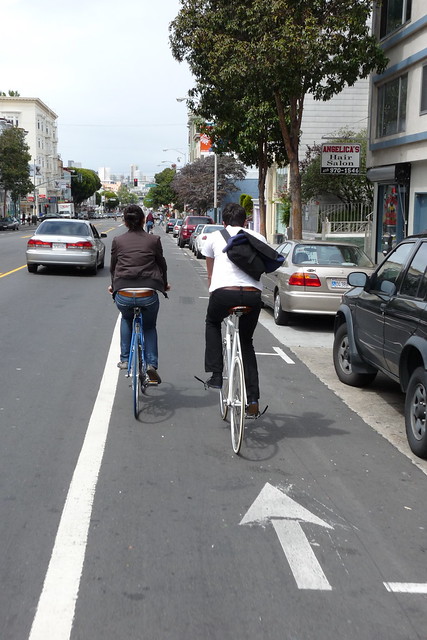
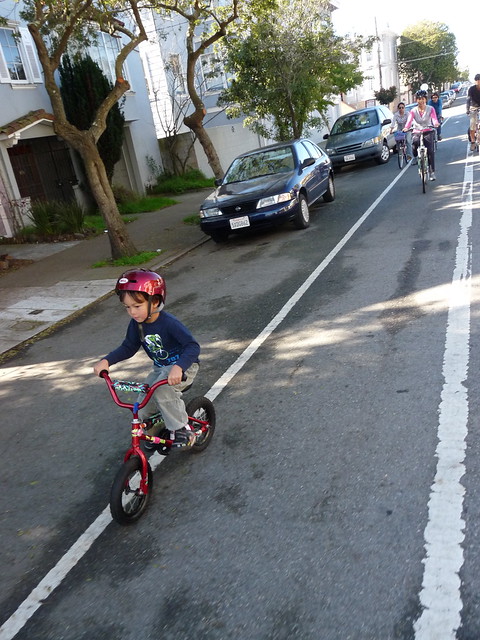
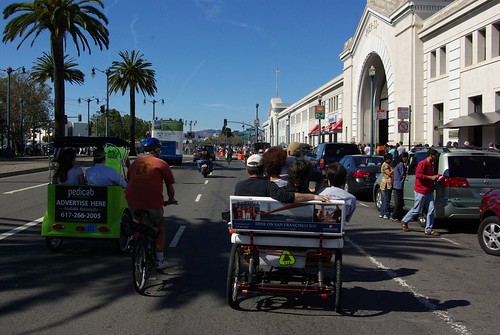
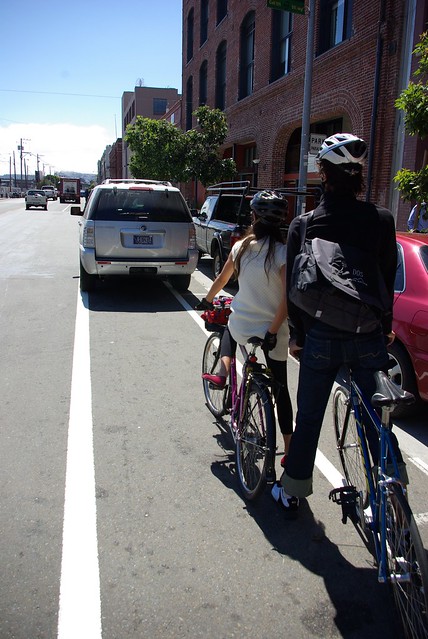
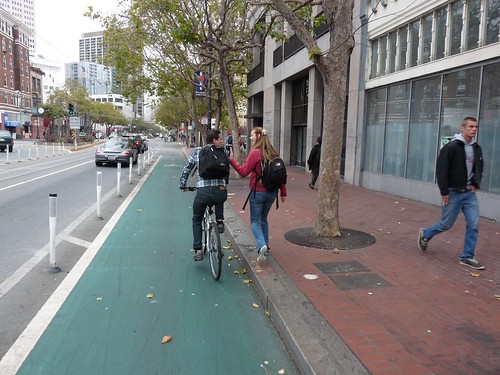




Wonderfully put! I'm so tired of the "cyclists are dangerous" vs "motorists are dangerous" debate. Even though I lean towards latter point of view quite heavily, I completely understand the point of view of a motorist who sees cyclist after cyclist blow through stop signs - it's understandable because I have the same but opposite view after seeing motorist after motorist blow through stop signs. But that's all fodder for another discussion.
ReplyDeleteYour point here about looking at facilities and improving them with all road users in mind is great and should be the focus of the conversation. Cyclists wanting safer facilities will benefit, motorists who want cyclists to ride more predictably will benefit.
Being from Portland I can tell you that while we've made a lot of progress, there are still a lot of concerns here as well. What we (all of us, regardless of city) need are two things:
1) comprehensive studies of different types of facilities to determine which are the safest and most efficient under different scenarios
2) standardization of road infrastructure, to the point its feasible, so that everyone is used to and comfortable with how exactly to use the road
...or we can just keep shouting and killing each other.
I just lost a really long comment, so I'll still post, but this one might be a little more concise... which might be a good thing, who knows :)
ReplyDeleteThe issue of speed is critical. So much of the damage done by our transportation system as-is, and the hysteria around protecting ourselves come simply from the fact that we allow and even push people to move faster than the limitations of their minds, bodies and vehicles.
Our road design needs to not only have separate space for bicycles and pedestrians, but it needs to restrict the speed of motorized traffic. If I remember right, in Amsterdam the speed limit is 30kph (about 18mph) unless marked lower, and the road design makes it so that it isn't comfortable to drive faster than that.
The result is that if someone needs to cross the street, it's easy to stop. If someone steps or veers into the street, it's not nearly as stressful for the people driving, as they actually *can* stop in time and control their vehicle reasonably.
People don't feel an overactive need to protect themselves, because they are comfortable that they are moving within the limits of their own personal limitations and their vehicle's limitations (both on a bike and in a car).
As opposed to here, where we just tell people - Move as fast as your car will take you, if something gets in your way, it's their fault for being stupid. People driving feel the burden of moving fast as well - that's why having other people in the roadway is so stressful - if speeds were slower, it wouldn't cause the fear/anger reaction towards other road users, because it wouldn't cause an extreme panic reaction in a person driving if someone stepped into the road, because they would know they could stop in time and reasonably control the situation.
Just another way America is way out of balance.
I am with you on the speed thing. In California, street speed is determined by the speed people drive on roads. If 85% of the drivers drive at 35 MPH then that is the speed. It is also what used to keep roads from having traffic speed reduced. For those who wish to use those roads, they better damn well keep up or get out of the way.
ReplyDeleteI am fascinated by how seductive this way of doing things has become. As a society we have become comfortable with being profoundly uncomfortable. It is like having a bad tooth but being too afraid to go to the dentist to have it taken out, so we just learn to live with it. Even though the pain of pulling it would last only a moment, we put off the visit.
So, even though the pain of changing our roads would be uncomfortable for a little bit, the end result would be better for all. if only we could take that step.
I think this applies to cyclists as well - I think much of the "protect yourself" mindset, specifically around helmets, is because the assumption is that you're riding head-down and fast - because, well, that's how you do it. I've had a number of people say they probably wouldn't wear a helmet if they just rode 10-12mph, but they always ride faster, so they wear one. So essentially, because they feel they are pushing the limitations of their ability to control their vehicle, they need to take precautions in case they lose control.
ReplyDeleteI know that isn't the reason for everyone, but I think it definitely plays a part in a lot of our thinking - and especially in the thinking of people who can't imagine how anyone could be so stupid as to not wear a helmet.
I intentionally ride so that at any given moment, I am in control of my bike and I can stop or turn or whatever quickly. That means going slower than most people, but it also means that I don't feel this tension about moving around, and I don't feel the need to take unreasonable protective measures. And as opposed to riding as hard and fast as I can, it's about a 5 minute time loss over a 30 minute ride (I've done time comparisons). Well worth it to me.
I couldn't agree more! I also get frustrated when I do everything I'm supposed to - I wear a good helmet, use hand signals, respect red lights, use bike lights even at dusk - but have to ride in a car lane because the the physical condition of the street is so bad! Motorists also complain about cracked roads, holes, etc. but they have no idea how hard it is to go alongside rush-hour traffic, stay out of the car lane while avoiding getting doored, keeping an eye on potential motorists who look like they may be the kind to door me, AND look down all the time to prevent huge jolts from the bumps or even getting knocked down! Bad streets aren't good for a car's alignment, transmission, etc, but they're REALLY not good when they can physically hurt me! In Berkeley where I ride, this is so common especially since the majority of damage on the road is on the shoulders where cyclists are.
ReplyDelete